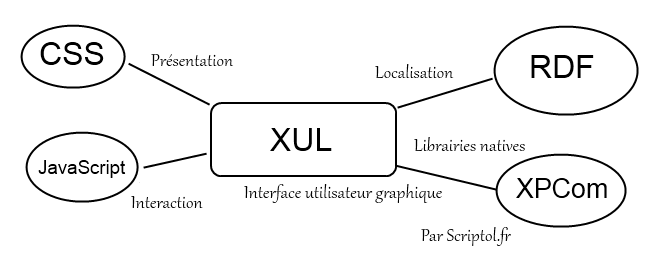XUL, GUI language
XUL is an XML-derived GUI language for applications. It is portable, runs on all operating systems with runtime Gecko, or XULRunner, but is difficult to implement.
XUL stands for "XML-based user interface Language," which is why the XML-based user interface language was created by Mozilla in 1999.
It seemed that XUL was destined to become a universal language for describing graphical interfaces. But Microsoft contrasted it with its version, XAML. In addition, developers have never sought to share development with third-party tools, resulting in many XML-based user interface languages. Finally, HTML 5, thanks to canvases, multimedia tags and frameworks that can expand HTML with new tags, has established itself as a valid alternative.
In 2014, XUL seems to have limited itself to Firefox and Mozilla tools, runtime XULRunner for creating application interfaces with this language is no longer supported and developers are thinking about completely or more accurately abandoning it, using Firefox as an application backend instead.
On the other hand, Microsoft's XAML is more relevant than ever on Windows and Mono.
In 2023, XUL was completely removed from the Firefox interface, which now uses the same components for its interface as web pages, therefore based on CSS.
Here is a graphical representation of the components working with XUL:

Based on Internet standards, but complex
The use of RDF, XBL and XPCom in particular makes it an elusive tool. XUL is characterized by:
- The XML is interpreted.
- JavaScript code is embedded in the XUL source for programming interface behavior.
- Uses raster graphics.
- Events (such as a mouse click) are tag properties, and tags are interface elements.
- Style properties are defined by style sheets in the standard CSS format.
- Elements (mainly "widgets," graphic components) can be defined by the user using XBL or XPF code.
- The RDF format is used to store textual content, for example, inscriptions in different languages.
- XPCom XUL interface with libraries written in different programming languages.
- You can integrate HTML code into XUL code and therefore run a web application locally on XULRunner.
Code Samples...
Show: "Hello world!":
<?xml version="1.0">
<windows width="600 height="480">
<description>
Salut le Monde!
</description>
</windows>
Drawinger button:
<button label="Fermer" oncommand="window.close()" />
To use XUL, first load the XULRunner runtime. Contrary to all expectations, new versions appeared in January and February 2014.
You will find documentation about Mozilla.
Electron is an alternative to XULRunner for building local JavaScript-based applications with XML and CSS for the interface .
See also XAML, the Windows 8 version of Microsoft XUL, or the HTML 5 section of this site.